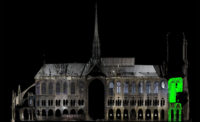Contractors modernizing a 55-year-old, legendary Southeast racetrack are pushing the limits of technology as they scramble to complete the complex project.
At Barton Malow Co.'s Daytona Beach, Fla., construction office, just down the street from the Daytona International Speedway, numerous wooden tables completely fill a large back office. But instead of printed blueprints, contractors focus intently on their smart boards, Apple TV screens and iPads as they race to transform NASCAR’s most well-known racetrack.
The Michigan-based contractor is leading the venue’s $400-million renovation project—which Daytona International Speedway (DIS) is calling Daytona Rising—that will completely transform the 55-year-old racetrack into a modern sports facility. A revamped facility with three concourses will replace the old-school grandstand-style seating that forced fans to walk up as much as 70 ft to their seats. In the new venue, fans will ride elevators and more than 40 escalators from one of the five main entrances and enter their seating area from behind. The concourses themselves will include twice the number of restrooms and triple the concessions, all while providing 11 "neighborhood" spaces for fans to gather.
This update will be a dramatic change for the iconic speedway, which hasn’t changed much since it first opened in 1959. For now, an estimated 100,000 race fans—the track’s current capacity stands at over 165,000—can still pack into the original, 1950s-era grandstand seats that extend for nine-tenths of a mile along the track’s 31-degree-banked front stretch.
Since last October, crews have been erecting the more than 40,000 individual pieces of steel at the track’s west end. Throughout the course of the build, the new galvanized-steel structure will rise 140 ft high. The length of the new building requires taking into account seven inches' worth of the Earth’s curvature. At more than 40 million pounds total, it is estimated the Daytona Rising project will account for about 1% of the nation’s annual steel output.
Now, just days before the Feb. 23 Daytona 500 race, crews are clearing a path for the "speed week" that leads up to the "Great American Race." Then, once again, they will hit the ground running in a high-tech fashion as they head for their January 2016 finish line—all while racing continues on the 2.5-mile tri-oval track.
Technology Emphasis
For its own race, design-builder Barton Malow will lean heavily on technology to keep contractors and engineers in sync. "We have more sheets of drawing and specs than people in the seats on race day,” says Jason McFadden, the contractor’s director of project management. “It was imperative to figure out a way to get everyone linked."
Len Moser, project director, says the job’s No. 1 challenge is timing. The No. 2 challenge includes the complete removal and rebuild of the main grandstand tower within a tight timeframe. So, in reality, that is all about timing, too.
"The schedule is the driver on the site,” Moser says. “The labor is available, but if material is not here, we are dead in the water.”
Joie Chitwood, president of DIS, a subsidiary of Daytona Beach, Fla.-based International Speedway Corp., concurs. “We are not changing the dates of the Daytona 500,” he says. “It is a logistical challenge and the No. 1 risk. We just need to get there."












